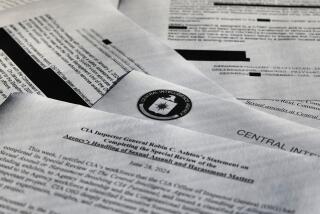CIA Heavily Infiltrated in Russia, Report Finds : Espionage: Operations in ‘80s severely compromised, Ames study shows. Senior officials were often kept in dark.
- Share via
WASHINGTON — The Central Intelligence Agency has determined that its espionage operations inside Russia in the 1980s and early 1990s were riddled with double agents who fed streams of disinformation back to the United States and were undetected for years until Soviet mole Aldrich H. Ames was arrested.
What’s more, some CIA officials may have realized that their operations had been compromised by the Soviets--and failed to inform the White House or senior U.S. policy-makers of just how badly U.S. spy operations had been penetrated.
Sources said that those are some of the explosive findings of the CIA’s long-awaited internal “damage assessment” of the Ames spy case, to be formally presented to Congress today. Ames spent much of his CIA career in Soviet counterintelligence.
Sources who have seen the damage assessment said that it represents a devastating blow to the CIA, and could have far-reaching consequences on Capitol Hill. The report also proves that the Ames case was more harmful to the CIA’s clandestine operations than has ever been publicly reported in the media.
“It is really, really bad,” said one source.
“This is not a pretty sight for the agency,” added another. “It’s much worse than anybody realized.”
CIA Director John M. Deutch is scheduled to testify today on the damage assessment during closed hearings of both the House and Senate Intelligence committees.
They suspected last summer, well-placed intelligence sources added, that some senior officials in the agency’s clandestine espionage service wanted the investigation to be short-circuited because it was potentially so explosive. Such suspicions were never proved but sources said that such concerns were prompted by the fact that “people were trying to cut the assessment off too early. We had suspicions that people in the Directorate of Operations [the CIA’s clandestine espionage arm] were trying to cut short the assessment before the full magnitude of what had happened was known.”
Other sources denied that any effort was mounted by senior CIA officials to limit the investigation. They pointed out that Deutch personally had made the decision to delay the release of the report to allow the damage assessment team to pursue unanswered questions.
*
In fact, when Deutch was told of some of the most damning findings, he urged that the scope of the investigation be broadened, the sources said.
Ames, a career CIA officer with a record for ineptitude and drunkenness, was arrested by the FBI in February, 1994, after spying for the Soviet Union--and later Russia--for nine years. As the most highly placed Soviet mole yet uncovered within the CIA, he is believed to be responsible for the deaths of at least 10 Soviets working as spies for the CIA and FBI in the mid-1980s. The CIA’s failure to detect Ames for so long--when his spending habits and personal behavior probably should have set off alarm bells among the agency’s spy-hunters--is now widely seen as one of the CIA’s greatest intelligence failures.
The agency has been working ever since to gauge just how badly Ames hurt American intelligence efforts but agency officials have been frustrated by the murky nature of espionage--and by the broad access to top-secret information given Ames during his career. The CIA’s damage assessment team was led by Richard Haver, former executive director for intelligence community affairs, who previously had headed a damage assessment effort after an earlier spy case.
In a complex and multilayered process, the CIA’s damage assessment team has had to try to identify every CIA informant--an “asset” in CIA jargon--known to Ames, then painstakingly sift through the information that those assets had given to the CIA.
The assessment team then studied the resulting information to determine if it was factual, thus providing evidence of whether an asset had been turned into a double agent by the Soviets. “You track back,” one source said. “You say, Ames [betrayed] the following sources and, if he gave away these sources, then the Russians would have to know about another set of sources. You figure if they knew about Mr. Smith, then they might have known about Mr. Jones. And then you try to figure out how many double agents you can identify.”
To its horror, the CIA has determined that many had been turned against the CIA--either with information provided to the Soviet KGB by Ames, or through other means.
The damage assessment has not identified any other American moles within the CIA who were working with Ames. Instead, the double agents identified in the damage assessment were Russians who the CIA thought were working for the United States--but in fact were working for the KGB. They had either been compromised by Ames and then forced by the Soviets to act as double agents or had been KGB double agents all along.
“We did find double agents,” a source said. “The exposure of Ames led us to identify a lot of material that was given to us by agents who we thought were working for us but who were actually feeding us information from the Soviets.”
The CIA’s inspector general, who is issuing a report accompanying the damage assessment, has found that some CIA officers apparently knew that some of their agents were feeding the CIA disinformation that was going into intelligence reports for senior policy-makers. But sources said that these officers failed to disclose what they knew, perhaps hoping to avoid censure for having worked with double agents. A Justice Department spokesman had no immediate comment on whether an investigation by the Justice Department would be conducted to determine whether there was any criminal wrongdoing.
To add another layer of intrigue and complexity, the damage assessment team also has had to confront the fact that some of the information fed to the CIA by double agents was accurate. This means that some of the information represented an attempt by Soviet leaders to make sure that U.S. policy-makers understood the Soviet position on critical issues, such as nuclear strategy.
Sources noted, for instance, that the CIA was given secret documents prepared by senior Soviet military leaders in the 1980s making the case that the Soviet military did not believe it could win a nuclear war. The CIA now knows that the document was passed by a double agent with the knowledge of Soviet intelligence--yet the CIA is convinced that the document is genuine.
*
The Soviet military leadership may have wanted to dispel confusion among senior U.S. policy-makers about whether the Soviets were willing to launch a first-strike nuclear attack against the United States, the sources said.
“Where does that take you?” asked one source. “We were receiving what you could call controlled information--which is not the same as disinformation. We had to figure out how much of what we were given was a case of disinformation--enemy deceiving enemy--and how much was a case of the Soviets trying to make an issue clear to us to avoid distortion.
“How much of that was designed to convince us to reach dangerously wrong conclusions--as opposed to making sure that we get a better understanding of the real situation. That is the tough part.
“The question is, did we draw wrong conclusions from the information we were given? That is a far murkier question, and one that I think people will be debating for years to come.”
More to Read
Sign up for Essential California
The most important California stories and recommendations in your inbox every morning.
You may occasionally receive promotional content from the Los Angeles Times.













